With the upcoming launch of the mainnet and the gradual implementation of various roadmaps, Enso may become one of the key driving forces on the path to large-scale adoption of blockchain technology.
Author: Deep Tide TechFlow
Blockchain is an extremely efficiency-driven market:
Public chains revolve around TPS, aiming to bring faster transaction speeds; LST/LRT layers stack upon each other, dedicated to achieving higher capital efficiency; in the meme supercycle, various novel angles emerge daily, with many projects blooming and falling within just one day.
However, this efficiency does not seem to be reflected in the development of blockchain products:
If you want to develop a product based on a certain blockchain, you must first undergo intensive learning about that chain, understanding its consensus mechanism, account model, Gas design, development language, testing tools, and other important designs;
If you want to further enhance your product features, such as introducing location and payment functionalities for a hotel booking product, this is commonplace in Web2, where you can directly choose to integrate mature products like Google Maps and Alipay. However, in the blockchain world, in most cases, you need to build everything from scratch;
If you want to reach more ecosystem users, you need to support more chains, but each chain has its own rules, and the continuously lowering threshold for launching chains has brought more chains to the industry. You must act like a general expanding territory, conquering each blockchain ecosystem one by one to achieve broader integration…
Every step severely slows down development efficiency and significantly impacts product functionality and user experience, as developers always need to spend 90% of their energy to implement the most basic functions, leaving little room for innovation.
Who can help the blockchain developers trapped in the repetitive cycle of reinventing the wheel?
Dedicated to abstracting on-chain smart contract interactions and building shortcuts for blockchain development through Shortcuts, Enso is gaining more attention for its outstanding performance in lowering the construction threshold for developers and achieving intent interactions: according to official data, Enso currently supports over 75 projects and has achieved more than $16 billion in on-chain settlements.
In addition, Enso has completed a total of $9.2 million in financing, receiving favorable attention from several well-known institutions, including Polychain Capital, Multicoin Capital, Cyber Fund, Spartan, TheLAO, Ideo Ventures, Hypersphere, and Selini Capital, while attracting over 60 industry leaders as angel investors.
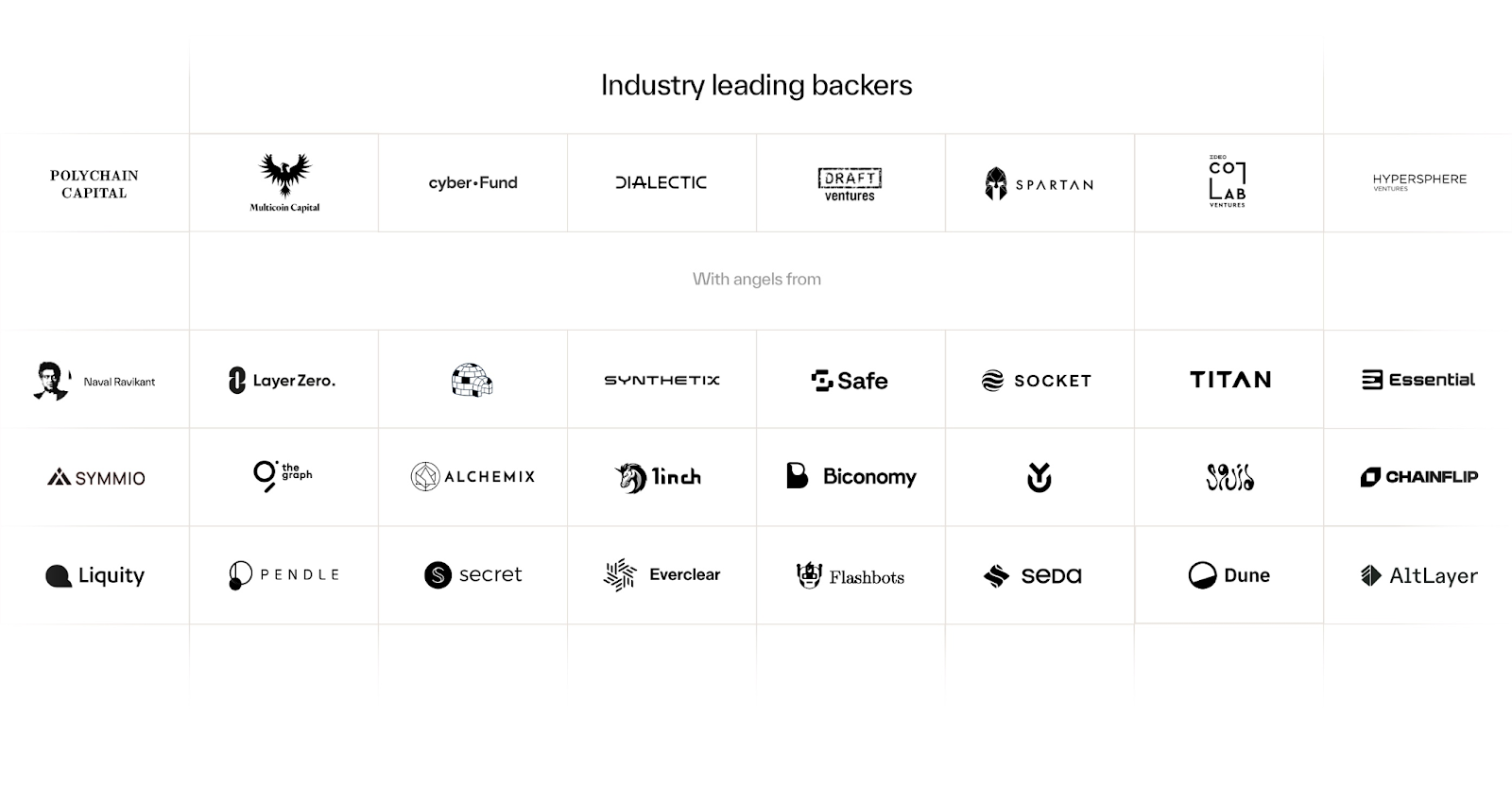
Behind the choice of both developers and institutions, how does Enso effectively address the complexities, repetitiveness, inefficiencies, and high costs of blockchain development?
From the initial API product to the Enso Shortcut Engine, and to the upcoming decentralized network Enso Network built on Cosmos, which allows everyone to participate and benefit, let’s delve into how Enso uses Shortcuts to achieve chain abstraction and promote large-scale adoption of blockchain technology.
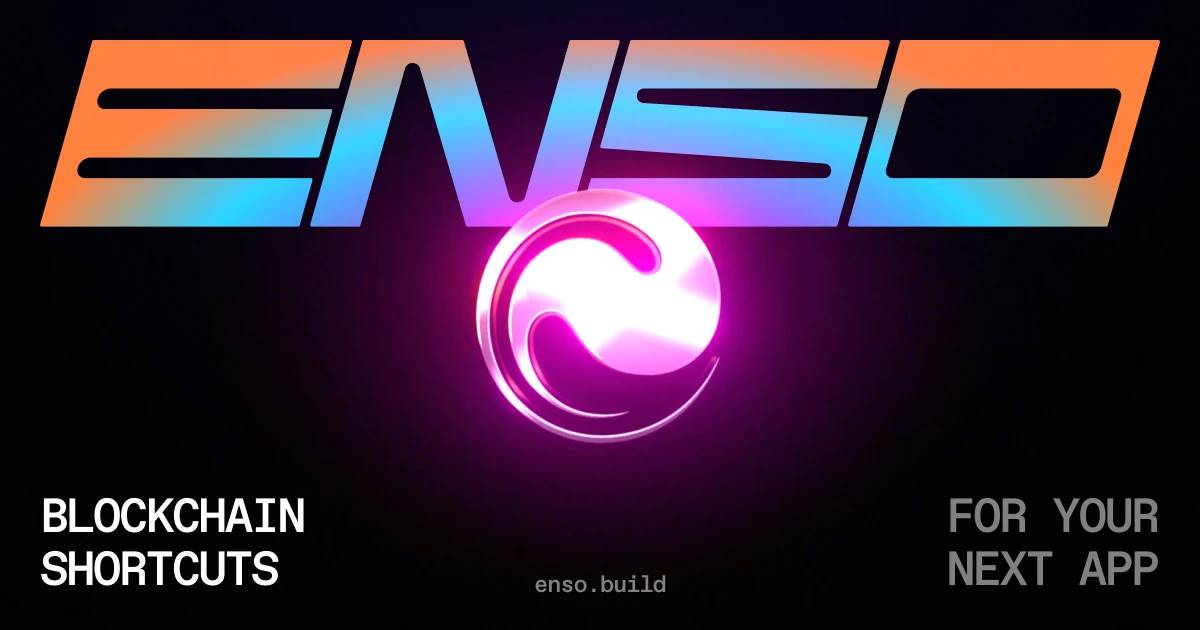
1.5 Days to Complete 7 Months of Development Work: A Direct Experience of Enso's Efficiency
Based on Enso's significant advantages in eliminating complexity across multiple protocols, this astonishing work efficiency comparison comes from the real development experience of Enso's partners:
Plug is an intent-driven on-chain activity automation platform aimed at building a Web3 version of Zapier, allowing users to manage, write, schedule, and execute all on-chain activities on its platform.
Before collaborating with Enso, OnPlug spent seven months on protocol integration development, with tedious and repetitive integration work consuming a lot of energy; after collaborating with Enso, OnPlug rebuilt the entire integration layer and completed the workload of the past seven months in just 1.5 days. This leap in development efficiency allowed OnPlug to focus more on automating Web3 activities, bringing great convenience to users.
In addition to improving development efficiency, Enso is also very adept at handling complex on-chain DeFi executions. The pre-deposit market Boyco launched by Berachain has sparked widespread community participation, and as a supporter behind Berachain Boyco, Enso has also received high praise:
We know that the demands in the Boyco market range from single-token deposits to multi-token strategies, which are quite complex. Manually integrating protocols, creating custom code for each market's specific needs, and conducting extensive testing and auditing is undoubtedly inefficient and costly.
Therefore, Berachain established a partnership with Enso to achieve rapid integration with all major DeFi protocols, ensuring compatibility across the entire ecosystem. Users can complete asset interactions with multiple protocols in the Boyco application through a single transaction, without needing to switch between multiple platforms or search for the best way to obtain the required assets, providing a more seamless participation experience and laying a solid foundation for Berachain's mainnet launch.
As of the writing of this article, with the support of Enso Shortcuts, Boyco's TVL has exceeded $3.1 billion.
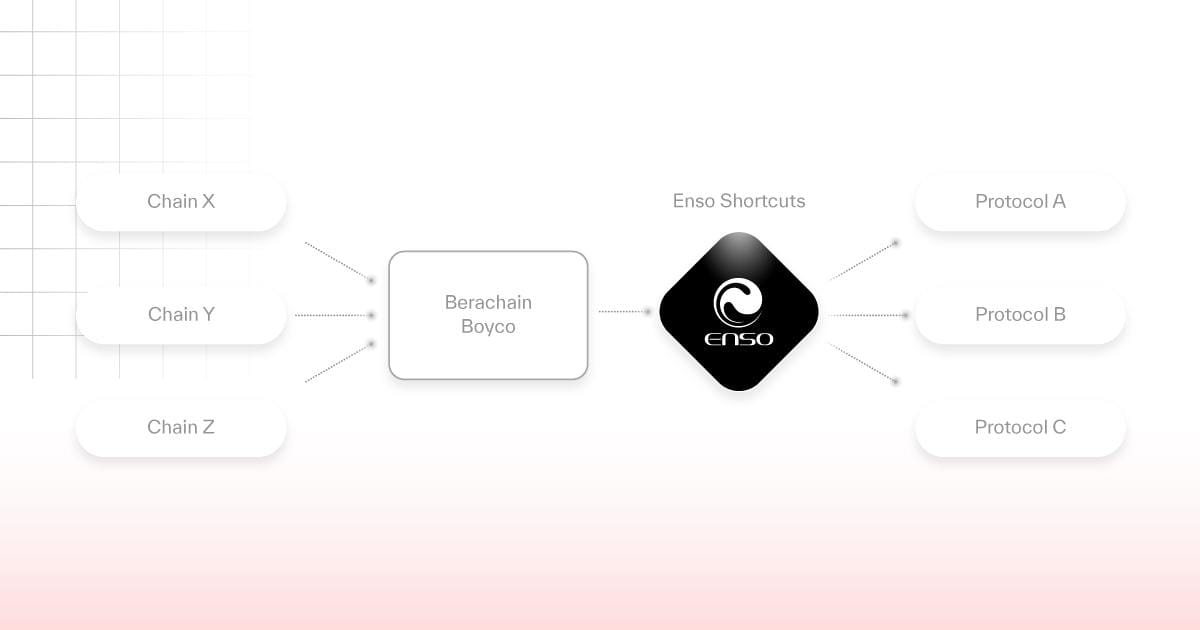
Additionally, the automated cryptocurrency trading market Glider also provides users with powerful portfolio automation features through Enso; Enso has launched on ZKsync, aiming to help developers build faster and more effectively; the multi-chain liquidity re-staking protocol Bedrock has partnered with Enso to offer users one-click asset swapping and deposits in the uniBTC Berachain vault.
Beyond the DeFi scene, the combination of Enso and AI is equally noteworthy:
In the ongoing AI Agent craze and the rise of the DeFAI narrative, DeFi, as a core pillar of the crypto world, aims to leverage AI to simplify the complex operational thresholds of DeFi, and DeFAI is widely regarded as promising.
As AI Agents evolve towards greater intelligence, Enso is dedicated to helping AI Agents overcome the complexities of interacting with multiple protocols, bundling transactions, and managing operations, empowering them with stronger execution capabilities:
BrianknowsAI, through integration with Enso, can focus more on developing their intent recognition engine without worrying about integration with multiple blockchain protocols;
Velvet Unicorn, as a self-managed hedge fund, quickly built advanced features such as neural network routing and multi-step yield strategies through collaboration with Enso;
Hey anon, as an AI Agent focused on DeFi, achieves interaction with over 180 on-chain protocols through Enso…
Such examples are countless.
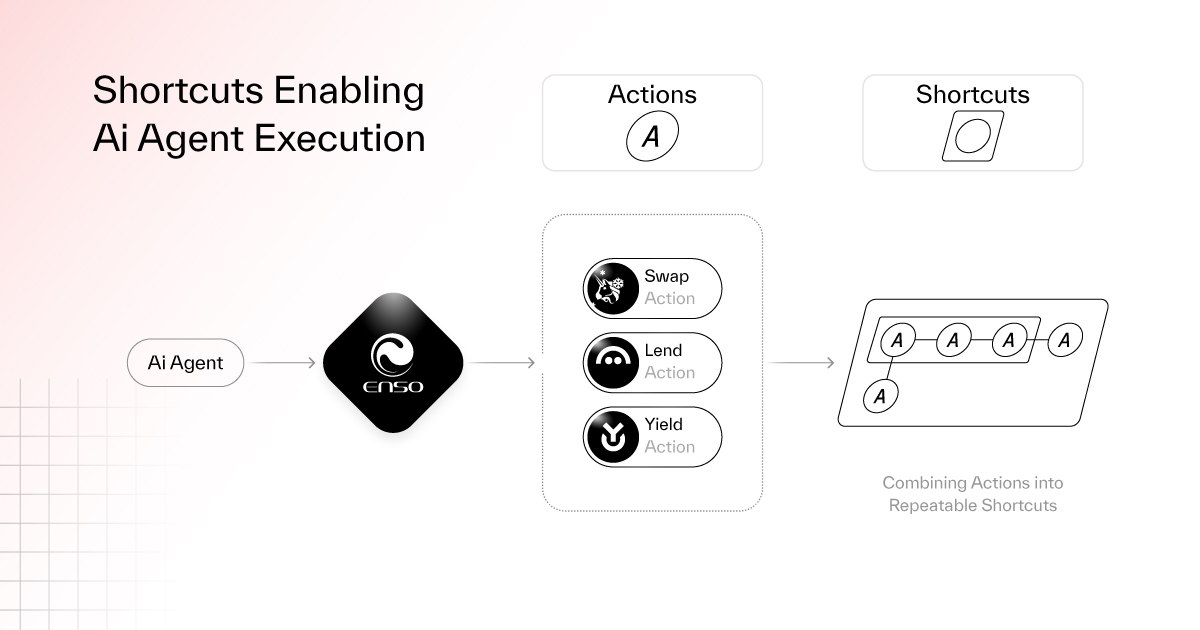
It is reported that Enso has now integrated over 180 protocols, with more than 60 apps utilizing Enso to leverage these integrations, and the Enso ecosystem's collaborative landscape is rapidly expanding.
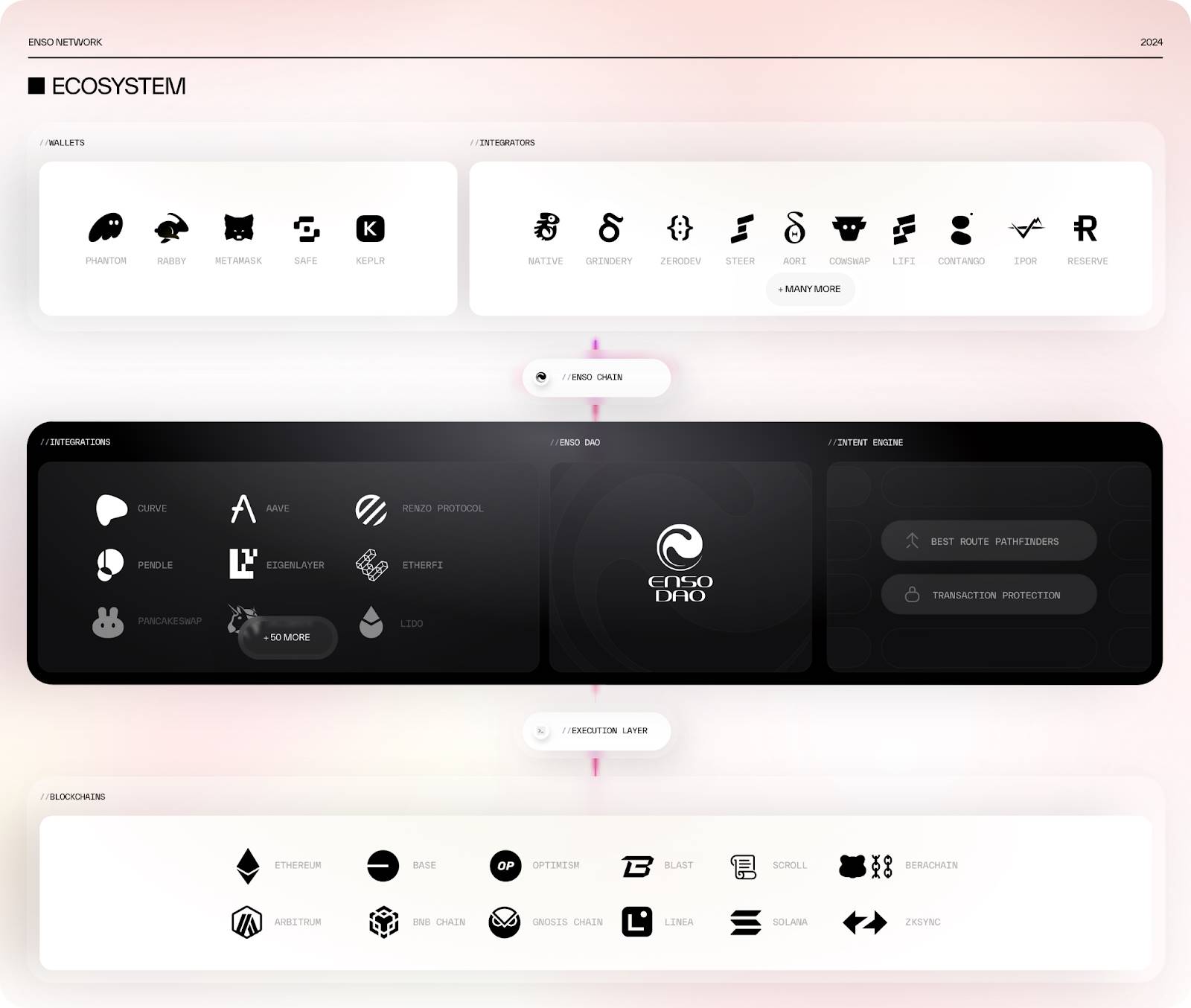
Behind a series of successful cases, many people are curious:
As a secret weapon for simplifying development processes, enhancing development efficiency, and providing seamless experiences for multiple projects, how does Enso achieve all this?
From API to Intent Engine to Shortcuts: Exploring Enso's Product Evolution
As the saying goes, practice brings true knowledge.
Enso did not initially determine a project development strategy centered on Shortcuts. After multiple attempts and adjustments based on products, as well as long-term observations of the needs in the crypto market, Enso's specific approach to enhancing blockchain development efficiency gradually became clear.
Starting with DeFi, Enso previously launched a social trading platform where anyone could create social strategies to monetize their investments in DeFi and ERC20 tokens. However, during the process of integrating more DeFi protocols, Enso spent a lot of time and incurred over $500,000 in high auditing costs to integrate 15 DeFi protocols.
After this experience, Enso realized that compared to specific DeFi products, the market needed services that could solve the development dilemmas of DeFi. Therefore, the team decided to rethink product design, reconstruct the underlying logic of the product, and subsequently launched a series of APIs, including Route API, Bundle API, Metadata API, etc., aimed at providing tools for executing and obtaining all relevant metadata of DeFi protocols. This includes executing multiple transactions in a single atomic transaction, bundling multiple DeFi operations to create custom workflows, obtaining the best route based on a given expected path, and providing all metadata related to DeFi protocols. Developers only need to call the API to quickly embed on-chain operations into their products, enhancing efficiency for the next generation of DeFi development.
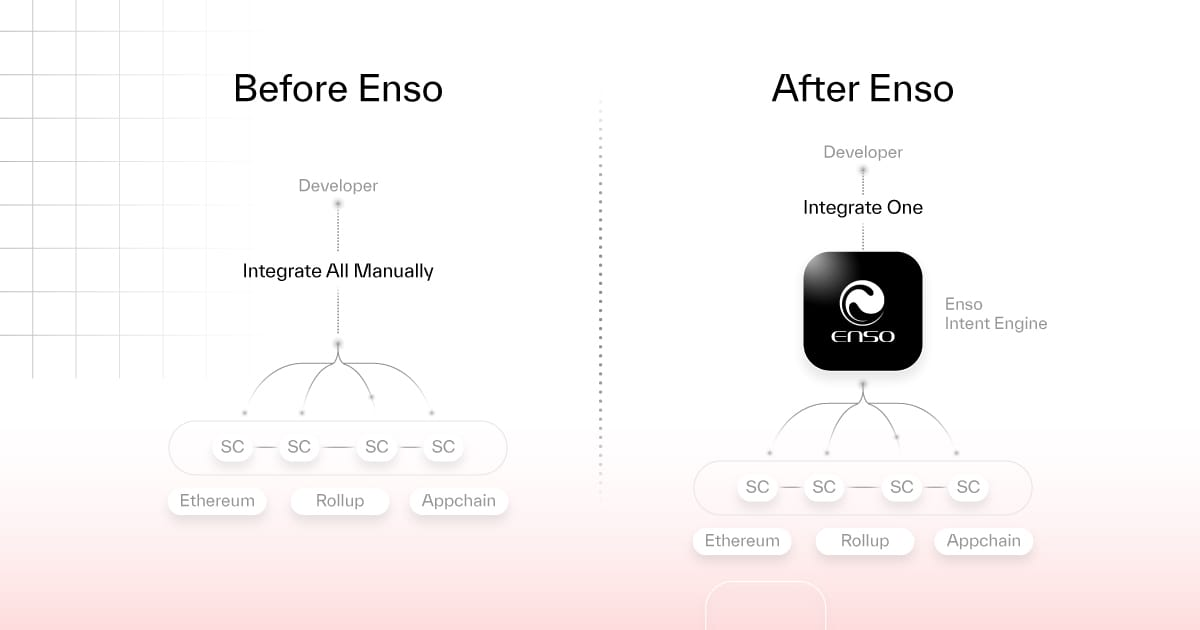
After the great success of the API, Enso deeply contemplated how to further help developers easily build products that can interact with any smart contract on any blockchain framework.
Based on this, in June 2024, the intent engine Enso Intent Engine was officially launched.
As a completely decentralized shared network state, the Enso Intent Engine aims to simplify smart contract interactions on the blockchain and support the construction of tradable data across various blockchain frameworks. This is achieved through a map of all smart contract interactions within the blockchain framework.
In simple terms, if we compare the blockchain industry to the Earth, each blockchain represents a country, and the applications within each blockchain are like cities within each country. Cities have various facilities such as schools, shopping malls, and parks, while applications include various operations like lending, borrowing, exchanging, transferring, approving, and depositing.
Previously, countries did not interact with each other, meaning data was not shared between blockchains. To integrate a chain or a smart contract, one had to learn and adapt to the laws of that country and city.
Enso aims to draw a global map that records the laws of all countries and cities (i.e., all blockchains and smart contracts) and presents them in standardized data formats, transaction formats, and execution formats. This way, developers can achieve easy integration through the standardized layer built by Enso.
Therefore, in Enso, developers only need to express their intent, and complex blockchain interactions can be automatically handled. The intent requests do not have to be explicitly targeted at a single use case; they can encompass various types of smart contract interactions across multiple blockchain frameworks.
For example, on this shared map, just as one can gather all parks through the "park" label on a global map, we can achieve data collection and analysis across all lending protocols through the "Lend" operation type.
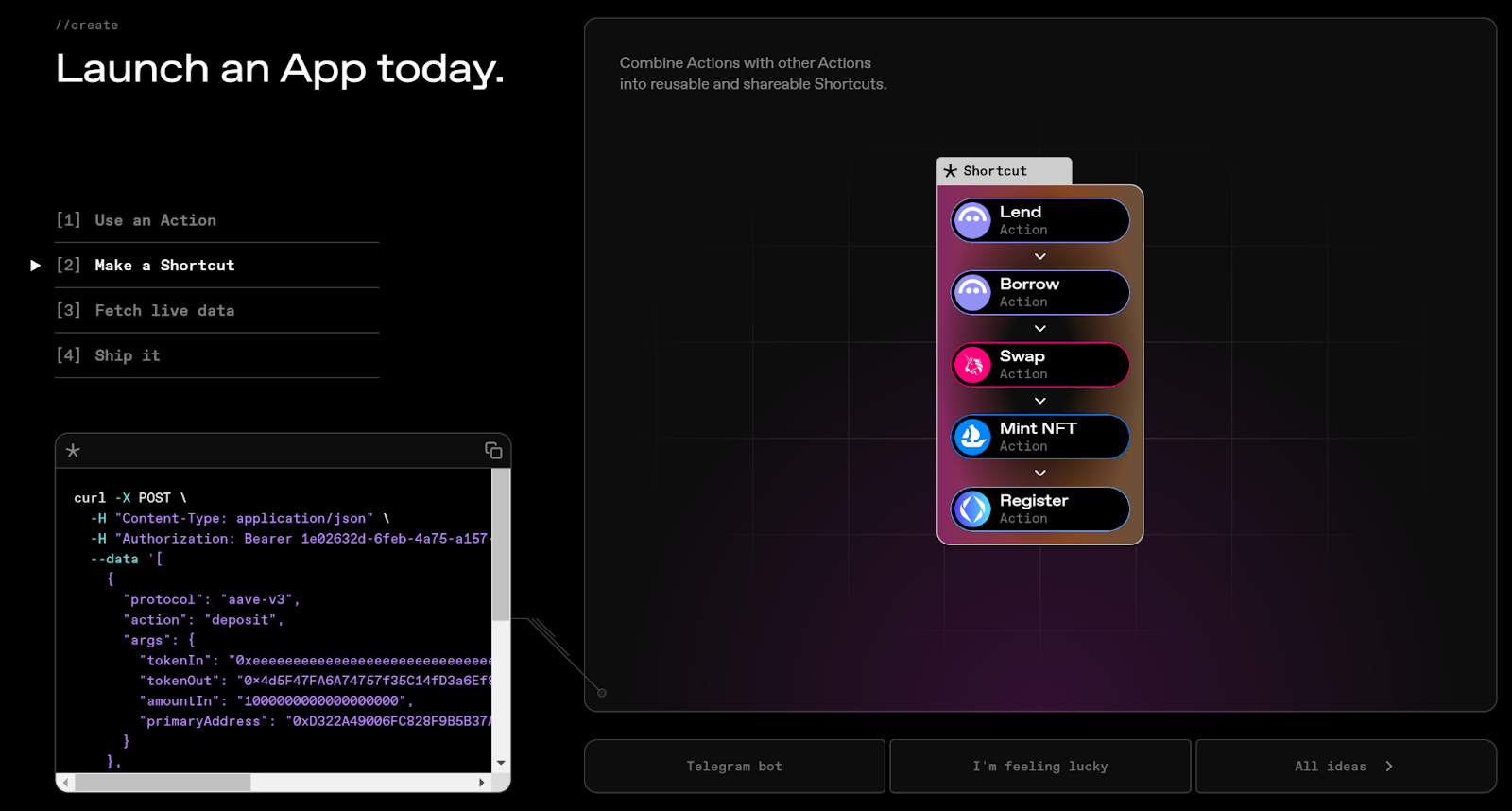
Based on the concept of this shared map from the Enso Intent Engine, combining different operation types as needed can give rise to a series of Shortcuts that significantly enhance blockchain development efficiency, transforming complex on-chain operations into simple, verified, and reusable building blocks.
In simple terms, standardized operation types are like Lego blocks, and developers can assemble these blocks into the shapes they desire. For instance, Lego blocks can be combined to form pre-built components like doors, windows, and walls, allowing you to easily construct any building you like, such as a school, hospital, or shopping mall.
Similarly, developers can combine different operation types to form various Shortcuts for DeFi routing, asset management, automated execution, and integrate these Shortcuts into the functionalities of various products.
Doesn’t that sound simple and efficient?
Currently, the Shortcuts that Enso has include:
Token swapping and DeFi routing
Asset management
Financial tools and automation
DeFi protocol integration
Smart contract interactions
Complex transaction bundling
At the same time, more Shortcuts are in the works. Several projects, including Berachain, ZKsync, and Bedrock, have significantly reduced the time and costs required for integration and maintenance through Enso, achieving over $16 billion in on-chain settlements, bringing more liquidity integration, innovative features, and high-quality user experiences to the blockchain ecosystem.
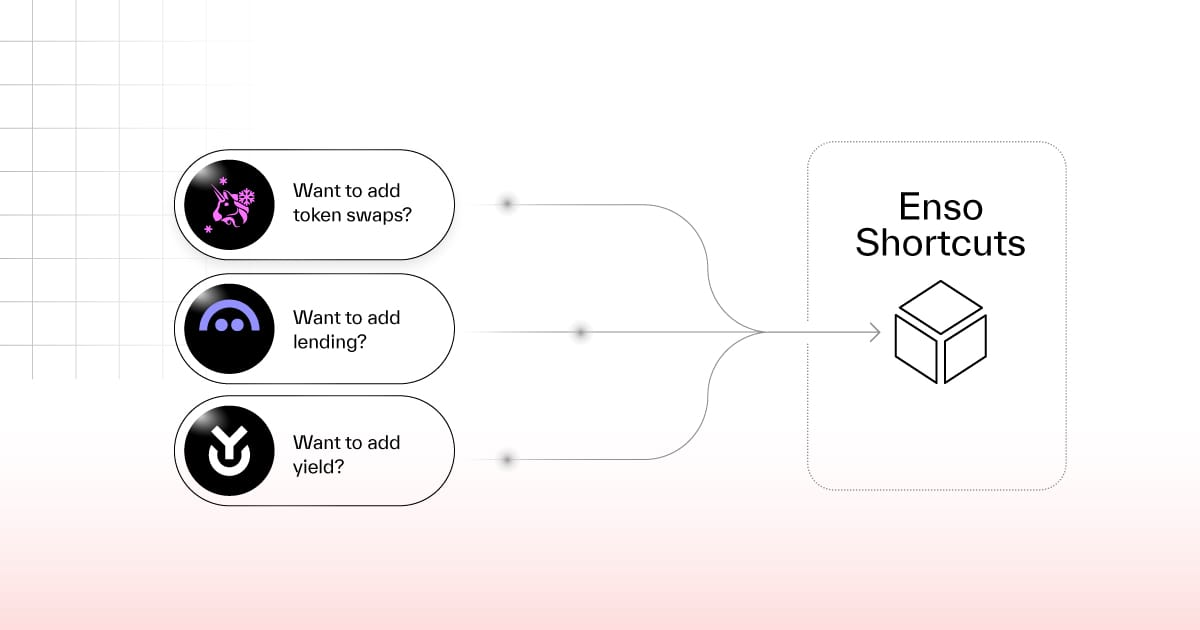
Behind the exquisite product design is a team of elite professionals with 10 years of experience in the blockchain field.
As the CEO and co-founder of Enso, Connor Howe has been working full-time in the blockchain industry since 2016 and published one of the earliest Ethereum research papers in the UK. Before founding Enso, Connor worked at Sygnum, a fully licensed digital asset bank in Switzerland, where he established the blockchain department and was responsible for developing fully collateralized stablecoins, tokenization suites, multi-signature products, and managed over $5 billion in assets using raw HSM.
Another co-founder, Peter Phillips, who is also the CTO of Enso, has been working full-time in the blockchain industry since 2016. Before joining Enso, Peter worked at a blockchain development agency with clients including DuckDuckGo and Mozilla, and developed Aragon through Autark, possessing extensive experience in blockchain development.
Milos Costantini is the core developer and co-founder of Enso. Before joining Enso, Milos built validator infrastructure for Swisscom blockchain, Switzerland's largest telecommunications company, and helped establish their blockchain department, making significant contributions to building the Enso network architecture.
It is worth mentioning that many community members may have noticed that the Enso Intent Engine currently provides services in a centralized manner, but Enso's core vision is decentralization, aiming to build an organic ecosystem where everyone can participate, contribute, and benefit.
With the upcoming arrival of Enso Network, the final piece of the decentralized puzzle is falling into place, and the vision of Enso's decentralized network is accelerating towards realization.
Next Stop Enso Network: Moving Towards Full Decentralization
As an independent L1 Tendermint blockchain, Enso Network is driven by network participants, providing efficient execution and extensive integration. We know that "achieving intent through Shortcuts" is the core concept of Enso, and the realization of intent involves three key elements:
Intent expression: Users specify the desired outcome in the application.
Intent execution: Solvers compete in auctions to determine the optimal solution for executing user intent.
Intent settlement: Solvers earn rewards by providing the optimal solution.
Enso Network achieves the logical closed loop of its decentralized network by introducing four key roles.
Consumers are the demand proposers who need to state their expected outcomes and pay fees to make requests to the Enso network.
Action providers are developers who publish smart contract abstractions on-chain. The network rewards developers who become Action providers based on the proportion of solutions generated using their smart contract abstractions.
Graphers are individuals who provide solutions based on consumer demands. Whenever new demands arise, Graphers will traverse all contributed abstractions in the Enso network and combine them in the optimal order to generate executable bytecode. As proposers of the optimal solutions, Graphers will receive rewards.
Finally, Validators are the core maintainers of network security, responsible for listening to and broadcasting valid requests from consumers in the network, validating the smart contract abstractions contributed by Action providers (only smart contract abstractions verified by Validators can be used by Graphers to generate solutions), and determining the optimal solutions from Graphers to feedback to consumers for execution.
We know that the design of the economic model plays a crucial role in the stable and positive operation of the ecosystem. The Enso network incentivizes network participants to engage through the native token $ENSO and constrains malicious behavior.
As a key component of the Enso ecosystem, the total supply of $ENSO is 100 million tokens, with the following key functions:
Gas: Payment for the fees required to initiate requests and modify states on the Enso network;
Governance: Facilitating governance protocol upgrades through token voting;
Staking: Action providers, Graphers, and Validators need to stake a corresponding number of tokens to participate in network contributions. When misconduct is detected, their staked $ENSO will be forfeited. Meanwhile, token holders can further maintain network security by delegating their stakes to network participants.
Based on this, the ecosystem of Enso, where everyone can participate, contribute, and benefit, is vividly taking shape.
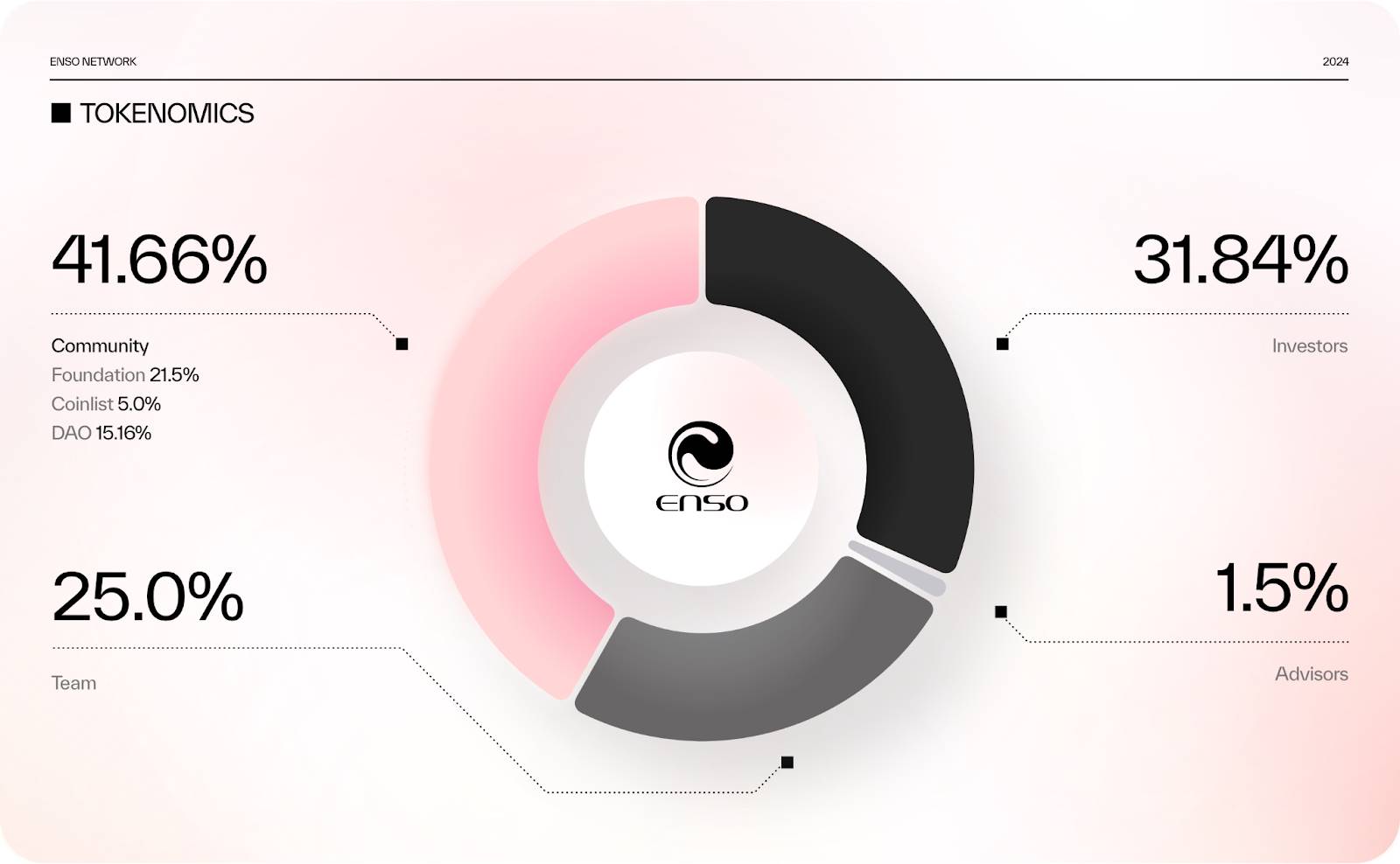
Conclusion
Of course, while the Enso API is already very mature and widely integrated into dozens of well-known projects, the development of Enso Network is still in a relatively early stage.
According to its white paper, the launch of Enso Network will be divided into two phases:
In the first phase, the centralized Enso service will coexist with the decentralized network. Developers intending to become Action providers can contribute to the centralized service hosted by Enso, while independent Validators will simulate bytecode solutions.
In the second phase, Enso Network will gradually transform into a fully sustainable ecosystem. Meanwhile, the network will provide a completely permissionless participation environment for key contributors such as Action providers and Graphers. Additionally, Enso Network will expand from supporting only the Ethereum Virtual Machine (EVM) to include the Solana Virtual Machine (SVM) and Move Virtual Machine (MVM) frameworks, further enhancing the developer experience in the multi-chain ecosystem.
According to official roadmap information, Enso Network is currently in the testnet phase and is expected to officially meet everyone in 2025.
It is particularly noteworthy that while Enso has achieved remarkable results in fields such as DeFi and AI, fundamentally, applications that wish to interact with smart contracts on any blockchain can find optimal solutions through Enso Network.
In other words, Enso Network has the capability to support any type of project. It is not limited to enhancing the development efficiency and service quality of applications like DeFi; it also has the potential to become a universal gateway for all smart contract interactions across all blockchains. As the trend of multi-chain futures becomes increasingly clear, Enso will be an effective way to help developers build truly scalable killer applications.
In the current blockchain development landscape, characterized by a surge in the number of public chains, deepening complexity of DeFi interactions, and a doubling of cross-chain demands, Enso's narrative of enhancing development efficiency and becoming a universal gateway for all smart contract interactions is undoubtedly attractive. Its evolution from API to intent engine to Enso Network also showcases the project's continuous refinement and deep commitment to the field.
With the mainnet's imminent launch and the gradual implementation of various roadmaps, Enso may become one of the key driving forces on the path to large-scale adoption of blockchain technology.
Enso Website: https://www.enso.build/
Enso X/Twitter: https://x.com/EnsoBuild
免责声明:本文章仅代表作者个人观点,不代表本平台的立场和观点。本文章仅供信息分享,不构成对任何人的任何投资建议。用户与作者之间的任何争议,与本平台无关。如网页中刊载的文章或图片涉及侵权,请提供相关的权利证明和身份证明发送邮件到support@aicoin.com,本平台相关工作人员将会进行核查。




